
Sugar Bay: A dream holiday destination for children
Kids all over the world are ditching their cellphones, and switching off the TV in favor of spending a school holiday at Sugar Bay Kids Resort in KwaZulu Natal. But that’s not the surprising part, the real surprise is that kids are going on holiday for an entire week (or two) without their parents. That’s right, Sugar Bay is a kids-only resort where children 7-17 years old can enjoy a safe, fun and parent-free holiday. For the working parent, this eliminates the stress of trying to arrange supervision and entertainment for their kids when the school holidays approach. Sugar Bay provides 24/7 supervision and all-day entertainment. Simply book online or give them a call, and they will handle everything for you, even your child‘s transport! Transport to the Resort Your kids can catch Sugar Bay‘s private bus service from Sandton, or catch a flight to King Shaka International Airport. The camp counselors, which are basically au-pairs also trained in Emergency First Response and Child Psychology, will escort your little ones safely to Sugar Bay – whether from their flight or during the bus trip. These transport options allow children from all over the world to enjoy a tropical beach holiday, and to make new friends from around the globe – without a cellphone in sight. Safety and Security With the highest staff-to-child ratio in the country (1:3) and over 18 years of experience, parents can rest assured that their little ones are safe and supervised. All water activities are supervised by qualified lifeguards, the property is secured by electric fences, 24-hour armed response, 25 CCTV surveillance cameras, night watchmen and fire alarms. The resort boasts facilities like a sports field, 25-metre pool with waterslides, paintball arena, indoor sports hall, theatre, infirmary and a waterfront with private access to the lagoon and beach. Unique themes every holiday Each school holiday is guaranteed to be a unique experience with different themes informing the itinerary and décor. Children are welcomed by superheroes, cartoon characters (and more) in an entirely new and imaginative setting from their previous visits. Accommodation Sugar Bay is a three-star establishment graded by the Tourism Grading Council. Nestled among trees and surrounded by sugar cane fields, the children sleep in spacious wooden cabins with en-suite bathrooms which are allocated according to age and gender. Additionally, all bed linen is provided and laundry is done for guests who stay longer than one week. Activities for all interests: Unlike other holiday camps, there are no compulsory activities at Sugar Bay. The children are free to choose from over 100 activities. Some popular activities include: Paintball and Airsoft Zip Lining Waterslides Bungee Trampoline Surfing Dance Lessons Skateboarding Kayaking Rock Wall Climbing Bmx Standup Paddle Boarding (SUP) Yoga Arts, crafts & baking. Kids deserve a great holiday break too – this is the concept behind Sugar Bay, which has created a winning formula for extraordinary fun and impeccable safety. Sugar Bay is an ideal getaway from today’s distracting technologies, and a perfect opportunity for kids to learn how to enjoy the outdoors. This children’s paradise is situated just 30 kilometers north of Ballito in a little seaside village called Zinkwazi Beach. The cost of a typical 7-day holiday includes accommodation, activities, three meals per day and 24-hour supervision. Naturally, parents may have concerns and questions before being convinced to send their kids away on a holiday alone. Sugar Bay’s friendly office will gladly chat to parents about their individual concerns for their children. Give them a ring on (032) 485 3778 or pop them an email at [email protected] . You can also watch this video for a preview of the camp’s facilities and the activities on offer. Get In Touch: www.sugarbay.co.za [email protected] (032) 485 3778


































